|
|
|
Sort Order |
|
|
|
Items / Page
|
|
|
|
|
|
|
| Srl | Item |
| 1 |
ID:
191485
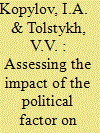

|
|
|
|
|
| Summary/Abstract |
This paper offers a definition of the scientific term "political factor." It offers a classification based on numerous criteria and grounds, as well as a methodology of assessing its influence on national defense management in the Russian Federation in light of the destructive policies of the US and its allies.
|
|
|
|
|
|
|
|
|
|
|
|
|
|
|
|
| 2 |
ID:
168197
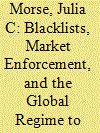

|
|
|
|
|
| Summary/Abstract |
This paper highlights how international organizations can use global performance indicators (GPIs) to drive policy change through transnational market pressure. When international organizations are credible assessors of state policy, and when monitored countries compete for market resources, GPIs transmit information about country risk and stabilize market expectations. Under these conditions banks and investors may restrict access to capital in noncompliant states and incentivize increased compliance. I demonstrate this market-enforcement mechanism by analyzing the Financial Action Task Force (FATF), an intergovernmental body that issues nonbinding recommendations to combat money laundering and the financing of terrorism. The FATF's public listing of noncompliant jurisdictions has prompted international banks to move resources away from listed states and raised the costs of continued noncompliance, significantly increasing the number of states with laws criminalizing terrorist financing. This finding suggests a powerful pathway through which institutions influence domestic policy and highlights the power of GPIs in an age where information is a global currency.
|
|
|
|
|
|
|
|
|
|
|
|
|
|
|
|
| 3 |
ID:
150670


|
|
|
|
|
| Summary/Abstract |
In China, the national target for energy intensity reduction, when integrated with target disaggregation and information feedback systems, constitutes a numerical management system, which is a hallmark of modern governance. This paper points out the technical weaknesses of China's current numerical management system. In the process of target disaggregation, the national target cannot be fully disaggregated to local governments, sectors and enterprises without omissions. At the same time, governments at lower levels face pressure for reducing energy intensity that exceeds their respective jurisdictions. In the process of information feedback, information failure is inevitable due to statistical inaccuracy. Furthermore, the monitoring system is unable to correct all errors, and data verification plays a limited role in the examination system. To address these problems, we recommend that the government: use total energy consumption as the primary indicator of energy management; reform the accounting and reporting of energy statistics toward greater consistency, timeliness and transparency; clearly define the responsibility of the higher levels of government.
|
|
|
|
|
|
|
|
|
|
|
|
|
|
|
|
| 4 |
ID:
150722


|
|
|
|
|
| Summary/Abstract |
The following paper presents a discussion of short- and long-term energy security assessment methods and indicators. The aim of the current paper is to describe diversity of approaches to energy security, to structure energy security indicators used by different institutions and papers, and to discuss several indicators that also play important role in the design of energy policy of a state. Based on this analysis the paper presents a novel Energy Security Matrix that structures relevant energy security indicators from the aspects of Technical Resilience and Vulnerability, Economic Dependence and Political Affectability for electricity, heat and transport fuel sectors. Earlier publications by different authors have presented energy security assessment methodologies that use publicly available indicators from different databases. Current paper challenges viability of some of these indicators and introduces new indicators that would deliver stronger energy security policy assessments. Energy Security Matrix and its indicators are based on experiences that the authors have gathered as high-level energy policymakers in Estonia, where all different aspects of energy security can be observed.
|
|
|
|
|
|
|
|
|
|
|
|
|
|
|
|
| 5 |
ID:
169136


|
|
|
|
|
| Summary/Abstract |
It appears that an almost unquestioned development pathway for achieving gender equity and women's empowerment has taken centre stage in mainstream development. This pathway focuses on economic outcomes that are assumed to be achieved by increasing women's access to material things, including cash income, loans, physical assets, and to markets. Gender equity indicators, which measure progress towards these outcomes, cannot escape reinforcing them. We argue that far from being neutral, indicators are embedded in political and ideological agendas that serve as guides to the appropriate conduct of those whose performance or behaviour is being measured. Drawing on participatory feminist, diverse economies and strengths based approaches, we outline a research methodology for developing community‐based indicators that recognises women's and men's participation and relationships in all spheres of life, including the ‘non‐economic’. If indicators are grounded in local meanings and realities, we propose that community members can use them to identify aspirational goals for gender equity, and measure progress towards these goals.
|
|
|
|
|
|
|
|
|
|
|
|
|
|
|
|
| 6 |
ID:
099214


|
|
|
|
|
| Publication |
2010.
|
| Summary/Abstract |
Improved energy efficiency is a key policy goal of all International Energy Agency (IEA) member countries, but tracking energy efficiency gains is not straightforward. As part of its contribution to the G8 Gleneagles Plan of Action, the IEA has been developing in-depth indicators-tools that provide data and analysis of energy use and efficiency trends. This paper gives an overview of the IEA indicator methodology and presents examples of how disaggregated indicators can be used to identify the factors that drive and restrain energy demand at the end-use level. A decomposition approach is also used to separate efficiency effects from the impacts of structure and activity. The results clearly show the important role that energy efficiency has played in shaping trends in final energy use in IEA countries for more than 30 years. However, the analysis also reveals that recent gains in energy efficiency have been much lower than in earlier decades. Accelerating energy efficiency improvements is therefore a crucial challenge for IEA governments and indicators have an important role to play in helping to develop and evaluate the policies that will be required.
|
|
|
|
|
|
|
|
|
|
|
|
|
|
|
|
| 7 |
ID:
088215
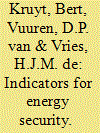

|
|
|
|
|
| Publication |
2009.
|
| Summary/Abstract |
The concept of energy security is widely used, yet there is no consensus on its precise interpretation. In this research, we have provided an overview of available indicators for long-term security of supply (SOS). We distinguished four dimensions of energy security that relate to the availability, accessibility, affordability and acceptability of energy and classified indicators for energy security according to this taxonomy. There is no one ideal indicator, as the notion of energy security is highly context dependent. Rather, applying multiple indicators leads to a broader understanding. Incorporating these indicators in model-based scenario analysis showed accelerated depletion of currently known fossil resources due to increasing global demand. Coupled with increasing spatial discrepancy between consumption and production, international trade in energy carriers is projected to have increased by 142% in 2050 compared to 2008. Oil production is projected to become increasingly concentrated in a few countries up to 2030, after which production from other regions diversifies the market. Under stringent climate policies, this diversification may not occur due to reduced demand for oil. Possible benefits of climate policy include increased fuel diversity and slower depletion of fossil resources.
|
|
|
|
|
|
|
|
|
|
|
|
|
|
|
|
| 8 |
ID:
094836
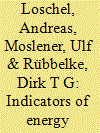

|
|
|
|
|
| Publication |
2010.
|
| Summary/Abstract |
Energy security has become a popular catch phrase, both in the scientific arena as well as in the political discussion. Yet, in general the applied concepts of energy security are rather vague. This paper sheds some light on concepts and indicators of energy security. First, we conceptually discuss the issue of energy supply security and explain why it is not to handle by one science alone and what economics may contribute in order to structure the topic. After providing a brief survey of existing attempts to define or measure energy security we suggest an additional dimension along which indicators of energy security may be classified: ex-post and ex-ante indicators. Finally, we illustrate our concept on the basis of several simplified indicators. While ex-post indicators are mostly based on price developments, ex-ante indicators are to a greater extent aimed at illustrating potential problems. Our illustration suggests that it is worthwhile to take into account the market structure along with the political stability of exporting countries.
|
|
|
|
|
|
|
|
|
|
|
|
|
|
|
|
| 9 |
ID:
168196


|
|
|
|
|
| Summary/Abstract |
In recent decades, IGOs, NGOs, private firms and even states have begun to regularly package and distribute information on the relative performance of states. From the World Bank's Ease of Doing Business Index to the Financial Action Task Force blacklist, global performance indicators (GPIs) are increasingly deployed to influence governance globally. We argue that GPIs derive influence from their ability to frame issues, extend the authority of the creator, and — most importantly — to invoke recurrent comparison that stimulates governments' concerns for their own and their country's reputation. Their public and ongoing ratings and rankings of states are particularly adept at capturing attention not only at elite policy levels but also among other domestic and transnational actors. GPIs thus raise new questions for research on politics and governance globally. What are the social and political effects of this form of information on discourse, policies and behavior? What types of actors can effectively wield GPIs and on what types of issues? In this symposium introduction, we define GPIs, describe their rise, and theorize and discuss these questions in light of the findings of the symposium contributions.
|
|
|
|
|
|
|
|
|
|
|
|
|
|
|
|
| 10 |
ID:
094833
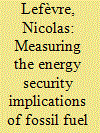

|
|
|
|
|
| Publication |
2010.
|
| Summary/Abstract |
Economic assessments of the welfare effects of energy insecurity are typically uncertain and fail to provide clear guidance to policy makers. As a result, governments have had little analytical support to complement expert judgment in the assessment of energy security. This is likely to be inadequate when considering multiple policy goals, and in particular the intersections between energy security and climate change mitigation policies. This paper presents an alternative approach which focuses on gauging the causes of energy insecurity as a way to assist policy making. The paper focuses on the energy security implications of fossil fuel resource concentration and distinguishes between the price and physical availability components of energy insecurity. It defines two separate indexes: the energy security price index (ESPI), based on the measure of market concentration in competitive fossil fuel markets, and the energy security physical availability index (ESPAI), based on the measure of supply flexibility in regulated markets. The paper illustrates the application of ESPI and ESPAI with two case studies-France and the United Kingdom-looking at the evolution of both indexes to 2030.
|
|
|
|
|
|
|
|
|
|
|
|
|
|
|
|
| 11 |
ID:
171498


|
|
|
|
|
| Summary/Abstract |
As highlighted by European policymakers and academic research, the global economic crisis of 2008 emphasized the energy poverty phenomenon. A number of households have had to considerably reduce their energy expenditure but the traditional criteria adopted to calculate energy poverty are not able to measure their number.
Placed in this framework, the paper aims to define a new measure of hidden energy poverty suitable to identify which Italian households restrain their energy consumption due to their inability to afford energy services. A review of the available energy poverty metrics supports the definition of a new indicator that is able to include hidden energy-poor consumers considering some key peculiarities such as the poor energy efficiency of buildings, the poverty situation, low energy consumption and sensitivity to the climate. Using data from the Household Budget Survey provided by the Italian National Institute of Statistics in 2018, the newly identified indicator supports the assessment of the percentage of Italian households in hidden energy poverty and supplies useful insight to policymakers in their effort to support vulnerable consumers.
|
|
|
|
|
|
|
|
|
|
|
|
|
|
|
|
| 12 |
ID:
103361


|
|
|
|
|
| Publication |
2011.
|
| Summary/Abstract |
The International Atomic Energy Agency reports that as of July 2009 there were 52 countries interested in building their first nuclear power plant. This paper characterizes and evaluates these "Newcomer Countries" in terms of their capacity and motivations to develop nuclear power. It quantifies factors historically associated with the development of nuclear energy programs and then benchmarks the Newcomers against these data. Countries with established nuclear power programs, particularly where nuclear facilities are privately owned, are typically larger, wealthier and politically stable economies with high government effectiveness. Nuclear power was historically launched during periods of high electricity consumption growth. Other indicators for the potential of nuclear power include: the size of the national grid, the presence of international grid connections and security of fuel supply for electricity production. We identify 10 Newcomers which most closely resemble the Established Nuclear Power Countries and thus are most likely to deploy nuclear energy, 10 countries where the development of nuclear energy is uncertain due to high political instability, 14 countries with lower capacities where pursuing nuclear energy may require especially strong international cooperation and 18 countries where the development of nuclear power is less likely due to their significantly lower capacities and motivations.
|
|
|
|
|
|
|
|
|
|
|
|
|
|
|
|
| 13 |
ID:
171465


|
|
|
|
|
| Summary/Abstract |
Europe is attempting to accelerate the development of renewables and, within the 2030 climate and energy framework, is required to achieve a share of renewable energy of at least 32%. However, the current share of renewables in the European transport sector (RES-T) is not adequate for reaching the 2020 target. The present work presents the trajectories of each Member State (MS) in attempting to achieve this goal and compares each MS in terms of RES-T, expressed in both percentage and per capita terms. Average European performance is used as a reference value. The results show that Sweden occupies a leading position, followed by Austria, Finland and France. At the same time, the trajectories of most MSs are not encouraging, but they may potentially be improved by the use of biomethane. This work analyses the strengths, weaknesses, opportunities and threats (SWOT) of this green gas. Several SWOT factors are examined and their relevance in a policy context is quantified using the analytic hierarchy process (AHP). The resulting integrated SWOT-AHP analysis defines a global factor priority. The work concludes that biomethane can potentially replace natural gas as a sustainable vehicle fuel, but its development is strictly linked to the adoption of governmental support programmes to stimulate market growth.
|
|
|
|
|
|
|
|
|
|
|
|
|
|
|
|
| 14 |
ID:
109689
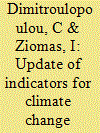

|
|
|
|
|
| Publication |
2011.
|
| Summary/Abstract |
This paper analyses the factors affecting greenhouse gas (GHG) emissions in Greece, (i.e. the drivers of pressures on climate change), using environmental indicators related to energy, demographics and economic growth. The analysis is based on the data of 2008 and considers types of fuel and sectors. The Kaya identity is used to identify the relationship between drivers and pressures, using annual time series data of National GHG emissions, population, energy consumption and gross domestic product. The analysis shows that over the period 2000-2008, GHG emissions show a slight variation, but they are almost stabilised, with a total increase of 1.6%. Despite the economic growth over that period, this stabilisation may be considered as a combination of reductions in the energy intensity of GDP and the carbon intensity of energy, which are affected by improvements in energy efficiency and introduction of "cleaner" fuels, such as natural gas and renewables in the energy mixture of the country.
|
|
|
|
|
|
|
|
|
|
|
|
|
|
|
|
|
|
|
|
|